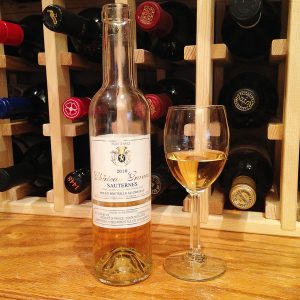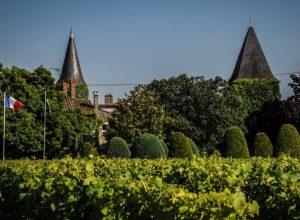Rich golden color; honey, honeysuckle, tropical fruit nose; honey, citrus, pinch of pear on the palate; dry, immensely rich, enough acidity to balance the sweetness; coats the palate in pleasure.
Sauternes are some of the world’s most expensive, longest-lived wines. The communes of Sauternes and Barsac are located on the west bank of Bordeaux, southeast of of Graves, almost due south of St-Émilion, hugging the curves of the Garonne River. Rains, river mists, humidity and climate encourages the development of botrytis (“noble rot”), a grey fungus which removes water from the grapes and amps up sugar, thus resulting in concentrated sweetness without loss of acidity.
This wine is made with 95% semillion (sémillon) and 5% sauvignon blanc, a standard mix; the sauv blanc gives an acidity boost to complement the extravagant sweetness of the desiccated semillion. Château Gravas was founded in 1789; it has been in the Bernard family for five generations, current owners are Michel and Florence Bernard. The château lies between two premier crus (Château Climens and Château Coutet) in the Barsac region; the name comes from the 10-acre vineyard’s gravelly soil. As is typical for sauternes, all grapes are hand-harvested so berries ruined by rot are not harvested among ones where the botrytis effect is perfect. Such attention in the harvest, and later in the winery, is what makes sauternes rare, delicious, and expensive.
Sauternes clearly is a desert wine—a little goes a long way; it famously pairs with blue cheese’s semi-sharp, tangy, lemony flavor. A comparable 375 ML bottle of Château d’Yquem—the most famous sauterne—retails for around $400, which makes this Château Gravas a solid value buy in its category. $20-22 (375 ML)
Château Gravas website (French language)
Second photo: Château Gravas


